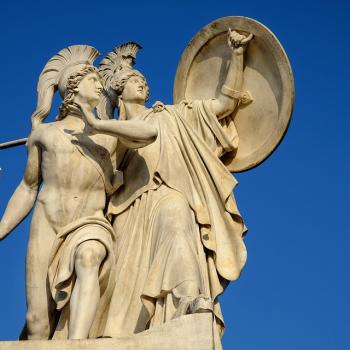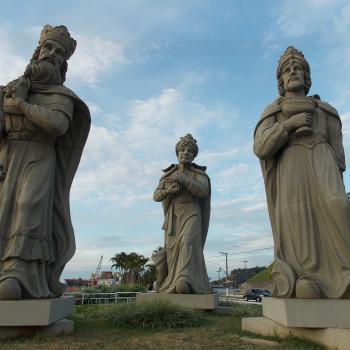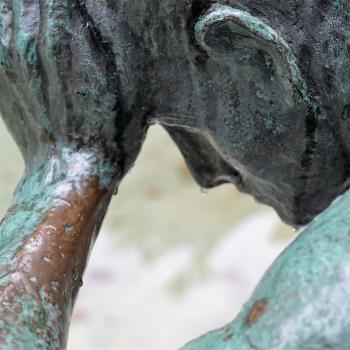“We want to see Jesus,” they said (Jn. 12.21). This request, from a group of anonymous Greeks who had come to Jerusalem, triggered Jesus’ awareness that “the hour has come.”
Augustine, too, recognizes the essential need to see Jesus. In his exploration of scripture, Augustine finds a steady engagement of God with creation through signs and theophanies throughout the Old Testament, culminating in the singular Sign and ultimate Theophany: Christ. If, then, Christ is the zenith of divine presence, the one human being in whom the gateway to God is opened for all people, then it is imperative that we see him.
So. Hmm. Seeing Jesus. I first think of the Bible in Pictures for Little Eyes that I read as a child. Did you? We would see Jesus in the temple, with the children, teaching the disciples, calming the storm. He always had clean white robes, a gentle posture, and a faraway look on his face.
Or there were the Warner Sallman images, so familiar to those of us “of a certain age”! Again, the distant gaze, the silent gaze, the placid demeanor.
The Head of Christ
Christ at Heart’s Door
The Good Shepherd
Is this what we need to do to see Jesus? Revisit art? Well, perhaps. (I’m really quite fond of the “Christ at Heart’s Door” painting… Actually, it always reminds me of Frances Hodgson Burnett’s The Secret Garden, and all these images of beauty and mystery and adventure and renewal (from the book) get mixed up with Christ longing to come into my garden and be with me. Not a bad brew, really.)
There is a value in seeing with the human eye. We cannot, perhaps, see him today (“for though you have not seen him, you love him; and even though you do not see him now, you believe in him and are filled with an expressible and glorious joy,” 1 Pet. 1.8), but good art can help us access the Christian memory that Christ actually walked this earth.
But it is not enough. We must see him afresh, see him in faith, grow in the love and knowledge of this God-Man. Anatolios encourages us, writing that “the ‘sight’ of Christ’s humanity … leads by faith to the sight of the Trinitarian being of God…” If we don’t keep our eyes on Jesus, we fail to see the Triune God—Father, Son, and Spirit. “Let us fix our eyes on Jesus, the author and perfecter of our faith…” (Heb. 12.2).
Where does that leave us, living as we do 21 centuries after Christ’s ascension? Augustine, really, had much the same problem. Four centuries, twenty-one centuries—not that much difference when you’re talking about seeing someone long gone. So Augustine’s counsel here offers us immediate relevancy. He gives us five characteristics of the “seeing” we need to do.
First, we see Jesus when we recognize that his work of salvation “manifests the extremity of God’s love” (Anatolios). It is love, and love alone, that saves us. This, Anatolios writes, is “a cure for both human pride and despair; it heals our pride through the recognition that our salvation was utterly unmerited by our sinful state, and it heals our despair by displaying that our sinfulness is not an obstacle to the power of divine love.”
It seems logical that this would be the first “sighting,” driven as we are both by pride and despair. If you think you are not so bad, and that God loves you because you’re such a stellar example of a human being (or at least you’re not so very bad, really, not as bad as ______), look at Jesus and see the truth about your soul. If you think you are such a contemptible carcass of humanity that God must surely despise you as you despise yourself, look at Jesus and see the truth about his love.
Second, we see Jesus when we understand that his death and resurrection serve as both sacrament and exemplar. Do not be put off by these words, for Augustine’s meaning here is profound and beautiful. They reiterate the theme of the Christodrama that we talked about last week.
When Augustine uses the word “sacrament,” he is talking about something we can see that shows us something we cannot see. So, Christ’s death is a sacrament—a visible sign—of the way the soul dies because of sin. “For the wages of sin is death…” (Rom. 6.23). “God made him who had no sin to be sin for us…” (2 Cor. 5.21). Christ’s resurrection is a sacrament of the way our soul is given new life. “For you died, and your life is now hidden with Christ in God…” (Col. 3.3). “If anyone is in Christ, he is a new creation…” (2 Cor. 5.17).
When Augustine uses the word “exemplar,” he refers to something that bids us move our hearts closer to Christ, responding to him in grace. So Christ’s death is an exemplar—an invitation—to our own martyrdom, our own self-denial. “If anyone would come after me, he must deny himself and take up his cross and follow me” (Mt. 16.24). “Put to death, therefore, whatever belongs to your earthly nature…” (Col. 3.5). Christ’s resurrection is an invitation to keep our eyes on the hope of eternal resurrection in him. “For the trumpet will sound, the dead will be raised imperishable, and we will be changed” (1 Cor. 15.52). “When Christ, who is your life, appears, then you also will appear with him in glory” (Col. 3.4).
These two ideas—sacrament and exemplar—grab the idea of vision (sacrament) and link it to action (exemplar). There is no point in seeing without responding; there is no way to respond without seeing. Christian life and practice require both faith (the sight of the heart) and works (the lurch of the heart toward him in obedience).
Third, we see Jesus when we rely on his intercession for us, drawing us into the fellowship with his Father. Here Augustine works with Jesus’ prayer in John 17, and his pleading for our unity, “that all of them may be one, Father, just as you are in me and I am in you. May they also be in us…” (Jn. 17.21). Our unity with one another and our relationship with the Triune God are interconnected. There is a fellowship of love within the Trinity, and Christ works always to recreate that fellowship of love among us, and between us and God.
It always saddens me when we do not teach believers to pray—fervently, daily, persistently—for this unity. Do we really think we can pursue fellowship with God and disregard the unity that Jesus longed for? On the other hand, when we urge a unity based on anything other than the love relationship within the Trinity—oh, say, a unity based on general goodwill, mere inclusivity, or political correctness—then we aim at something very different from what Christ pled for.
Fourth, we see Jesus when we understand that God’s entire salvation plan—from beginning to end—expresses an incomprehensible humility at the very heart of God. God’s willingness to descend to our places of misery, God’s willingness to undergo human suffering and an ignominious death—these are not the acts of a proud, self-satisfied, unbending God; they are the acts of mercy, tenderness, and compassion, flowing from a humble heart of love. God’s holiness, God’s sovereignty, and God’s glory would have been intact even if he had condemned us all to hell for eternity. But God’s love and his yearning for us could only be satisfied by humble descent. “This is how God showed his love among us: He sent his one and only Son into the world that we might live through him” (1 Jn. 4.9).
Fifth, we see Jesus when we rely on him as our high priest, offering the perfect sacrifice to cleanse us and restore right relationship with the Father. For Augustine, this is a liturgical argument, meaning that worship, culminating as it does in Eucharistic celebration and thanksgiving, helps us to see Christ always and ever as the perfect sacrifice. “This is my body given for you; do this in remembrance of me” (Lk. 22.19).
“We want to see Jesus.” Do you? Let me see that show of hands…
Having built the foundation of the vision of Christ, Augustine moves into an exploration of the ways that Trinitarian life is written within us. Created as we are in the image of God, Augustine believes he can find traces of that Trinitarian likeness in humanity. We see Jesus, who reveals to us the Trinity, and then we find echoes of that Trinity embedded in our very souls.
Next week, then, Augustine will guide us into the imago dei.
Note to Reader: This series on Trinitarian Spirituality explores the history and spirituality behind the shaping of the Nicene Creed using Khaled Anatolios’ Retrieving Nicaea: The Development and Meaning of Trinitarian Doctrine (Grand Rapids, MI: Baker Academic, 2011) as guide and inspiration. It’s best to begin at the beginning: An Introduction.












